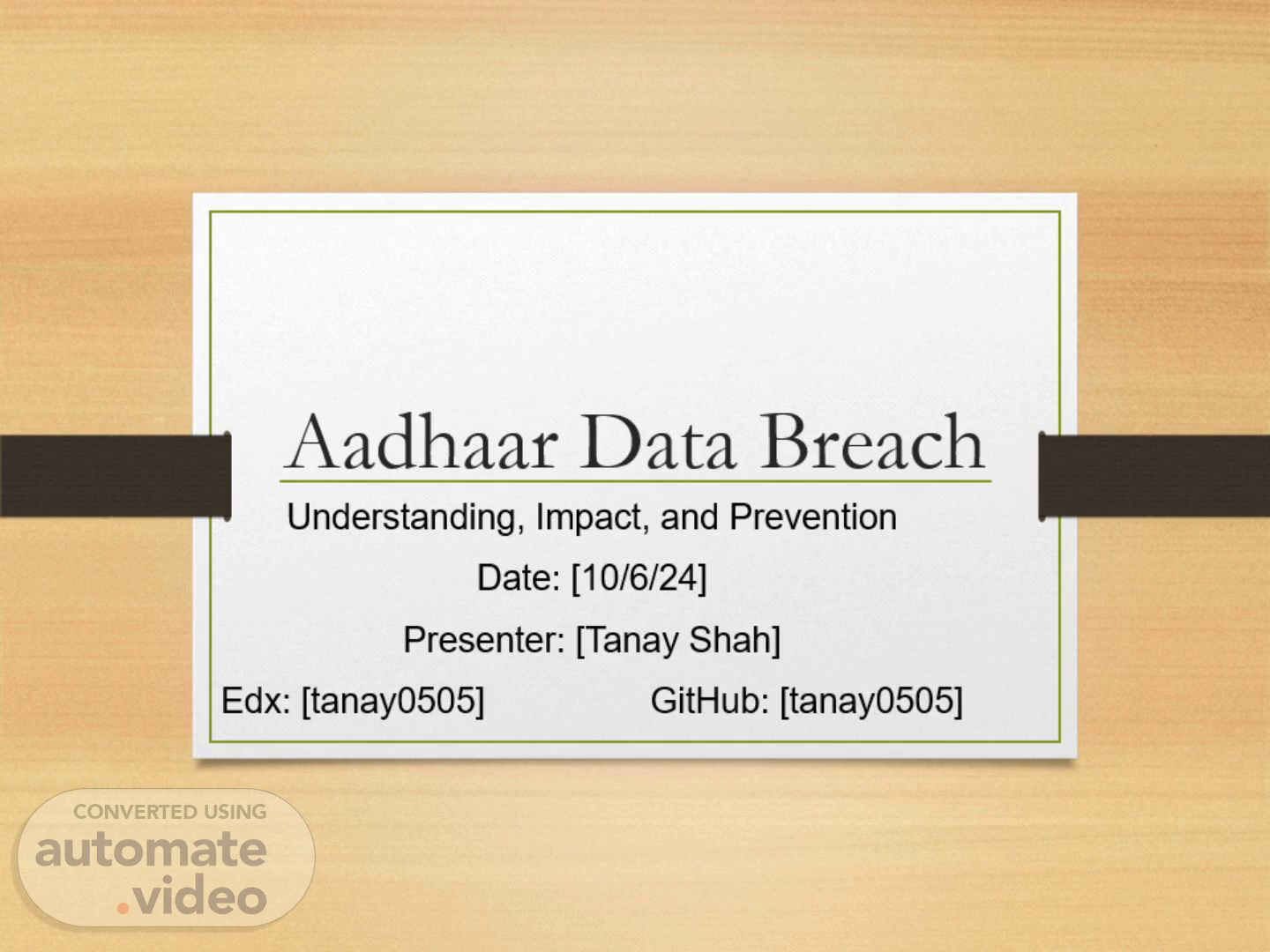Page 1 (0s)
[Audio] Aadhaar Data Breach Understanding, Impact, and Prevention Date 10/6/24 Presenter Tanay Shah.
Page 2 (10s)
[Audio] Overview of Aadhaar Aadhaar, introduced by the Unique Identification Authority of India (UIDAI), is a biometric identification system that assigns a 12-digit unique identification number to each resident. This number is intricately linked to an individual's biometric and demographic data, forming a comprehensive record. Importance of Aadhaar Designed to streamline and simplify the delivery of various government services, Aadhaar became a linchpin in the Indian government's efforts to enhance efficiency and transparency..
Page 3 (49s)
[Audio] The Scope of the Breach The Aadhaar data breach, a grim milestone in India's digital history, involved the unauthorized access and compromise of an extensive repository of personal data. The affected information included but was not limited to names, addresses, biometric data, and Aadhaar numbers. The sheer magnitude of the breach sent shockwaves through the nation, sparking concerns about identity theft, financial fraud, and the erosion of privacy on an unprecedented scale..
Page 4 (1m 21s)
[Audio] Root Causes of the Breach 1. Inadequate Security Measures The foundation of any secure digital system rests on robust security measures. In the case of Aadhaar, the breach underscored the presence of glaring weaknesses in its security infrastructure. Reports suggested that the encryption mechanisms in place were insufficient, access controls were lax, and the security protocols were outdated. These vulnerabilities created a fertile ground for malicious actors to exploit, leading to the compromise of sensitive data. 2.Insider Threats While external cyber threats are a constant concern, the Aadhaar data breach shed light on the menacing realm of insider threats. Speculations arose that individuals with privileged access to the Aadhaar database might have played a role in facilitating the breach. This revelation serves as a stark reminder that even the most robust cybersecurity measures can be undermined from within. 3. Lack of Regular Audits The absence of a systematic and regular auditing process emerged as a significant shortcoming in the Aadhaar system. Regular audits serve as a proactive measure to identify and rectify vulnerabilities before they are exploited by malicious entities. In the case of Aadhaar, the lack of a comprehensive auditing system allowed the breach to go undetected for an extended period, exacerbating the severity of the incident..
Page 5 (2m 52s)
[Audio] Identity Theft The breach raised alarming concerns about identity theft, as cybercriminals gained access to a treasure trove of personal data. With names, addresses, and Aadhaar numbers in their possession, malicious actors could impersonate individuals, leading to a surge in identity-related crimes. Financial Fraud A direct consequence of the compromised Aadhaar data was the surge in financial fraud. Armed with detailed personal information, cybercriminals could exploit individuals' financial accounts,leading to unauthorized transactions, fraudulent loans, and other monetary losses. Erosion of Privacy The Aadhaar breach raised existential questions about privacy in the digital era. The compromise of biometric data, in particular, triggered concerns about the misuse of sensitive information for surveillance or other nefarious purposes. Trust Deficit Perhaps the most profound impact of the Aadhaar data breach was the erosion of trust in digital systems and government initiatives. The breach shattered the perception of Aadhaar as an infallible and secure identification system, leading to skepticism among the public regarding the safety of their digital identities..
Page 6 (4m 8s)
[Audio] Continuous Monitoring and Auditing The incident highlighted the critical importance of continuous monitoring and regular auditing in maintaining the integrity of digital systems. Routine assessments can identify vulnerabilities before they are exploited, serving as a proactive measure against cyber threats. Encryption and Access Controls The breach underscored the significance of robust encryption and access controls in safeguarding sensitive information. Implementing state-of-the-art encryption technologies and stringent access controls is imperative to prevent unauthorized access to databases. Employee Training and Background Checks Insider threats can pose a significant risk to cybersecurity. Comprehensive employee training programs and rigorous background checks are essential to ensure that individuals with privileged access adhere to ethical standards and do not compromise the security of sensitive data. Public Awareness Educating the public about cybersecurity risks and best practices is crucial for fostering a secure digital environment. Increased awareness empowers individuals to take proactive measures to protect their data and enables them to make informed decisions about sharing personal information..
Page 7 (5m 29s)
[Audio] Strengthen Security Measures Addressing this aspect involves a comprehensive reassessment of the security protocols, the implementation of advanced encryption technologies, and the adoption of stringent access controls. The Aadhaar breach prompted a critical examination of existing security frameworks, leading to an urgent need for modernization and fortification. Enhance Legal and Regulatory Frameworks To counter insider threats, organizations must focus on comprehensive employee training programs and conduct rigorous background checks for individuals with access to sensitive databases. Creating a culture of cybersecurity awareness within the organization becomes crucial, emphasizing the ethical use of data and the severe consequences of breaches. Implement Comprehensive Auditing Framework The remediation of this issue necessitates the establishment of a robust auditing framework, wherein regular assessments are conducted to evaluate the efficacy of security measures. Routine audits act as a preventive measure, ensuring that any vulnerabilities are promptly addressed before they can be exploited. Increase Public Awareness Public awareness emerges as a powerful tool in the arsenal against cyber threats. Educating individuals about cybersecurity risks, best practices, and the protective measures in place fosters a sense of shared responsibility. Governments and organizations must invest in public awareness campaigns to empower individuals to make informed decisions about their digital footprint..
Page 8 (7m 5s)
THANK YOU.
